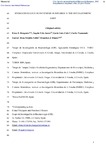Mostrar o rexistro simple do ítem
Hydrogen sulfide biosynthesis is impaired in the osteoarthritic joint
| dc.contributor.author | Burguera, Elena F. | |
| dc.contributor.author | Vela Anero, Ángela | |
| dc.contributor.author | Gato Calvo, Lucía | |
| dc.contributor.author | Vaamonde-García, Carlos | |
| dc.contributor.author | Meijide-Faílde, Rosa | |
| dc.contributor.author | Blanco García, Francisco J | |
| dc.date.accessioned | 2020-06-22T09:48:42Z | |
| dc.date.issued | 2019-11-16 | |
| dc.identifier.citation | Burguera EF, Vela-Anero Á, Gato-Calvo L, Vaamonde-García C, Meijide-Failde R, Blanco FJ. Hydrogen sulfide biosynthesis is impaired in the osteoarthritic joint. Int J Biometeorol. 2020 Jun;64(6):997-1010. | es_ES |
| dc.identifier.issn | 0020-7128 | |
| dc.identifier.uri | http://hdl.handle.net/2183/25755 | |
| dc.description.abstract | [Abstract] Osteoarthritis (OA) is the most common form of arthritis and it is a leading cause of disability in the elderly. Its complete etiology is not known although there are several metabolic, genetic, epigenetic, and local contributing factors involved. At the moment, there is no cure for this pathology and treatment alternatives to retard or stop its progression are intensively being sought. Hydrogen sulfide (H2S) is a small gaseous molecule and is present in sulfurous mineral waters as its active component. Data from recent clinical trials shows that balneotherapy (immersion in mineral and/or thermal waters from natural springs) in sulfurous waters can improve OA symptoms, in particular, pain and function. Yet, the underlying mechanisms are poorly known. Hydrogen sulfide is also considered, with NO and CO, an endogenous signaling gasotransmitter. It is synthesized endogenously with the help of three enzymes, cystathionine gamma-lyase (CTH), cystathionine beta-synthase (CBS), and 3-mercaptopyruvate sulfurtransferase (3-MPST). Here, the expression of these three enzymes was demonstrated by quantitative real-time polymerase chain reaction (qRT-PCR) and their protein abundance [by immunohistochemistry and Western blot (WB)] in human articular cartilage. No significant differences were found in CBS or CTH expression or abundance, but mRNA and protein levels of 3-MPST were significantly reduced in cartilage form OA donors. Also, the biosynthesis of H2S from OA cartilage, measured with a specific microelectrode, was significantly lower than in OA-free tissue. Yet, no differences were found in H2S concentration in serum from OA patients and OA-free donors. The current results suggest that reduced levels of the mitochondrial enzyme 3-MPST in OA cartilage might be, at least in part, responsible for a reduction in H2S biosynthesis in this tissue and that impaired H2S biosynthesis in the joint might be a contributing factor to OA. This could contribute to explain why exogenous supplementation of H2S, for instance with sulfurous thermal water, has positive effects in OA patients. | es_ES |
| dc.description.sponsorship | This work was financially supported in part through projects (PI12/00329; PI16/02124; RETIC-RIER-RD12/0009/0018; and Proteo-Red/ISCIII) from ISCIII- General Subdirection of Assesment and Promotion of the Research – European Regional Development Fund (FEDER) “A way of making Europe”, and in part by Grant IN607A 2017/11 from Xunta de Galicia. CIBER-BBN is a national initiative of ISCIII. LGC is financially supported by contract FPU13/06041 (Ministerio de Educación, Cultura y Deporte). CVG was financially supported by Xunta de Galicia (Postdoctoral contract POS-A/2013/206). EFB is financially supported by Grant PMP15/00032 from Fondo Investigación Sanitaria-Spain (ISCIII). | es_ES |
| dc.description.sponsorship | info:eu-repo/grantAgreement/MINECO/Programa Estatal de I+D+I Orientada a los Retos de la Sociedad/PI16%2F02124/ES/Determinación de índices predictivos de diagnóstico y pronóstico de artrosis de rodilla mediante la validación de biomarcadores proteicos | es_ES |
| dc.description.sponsorship | info:eu-repo/grantAgreement/MINECO/Acción Estratégica de Salud/RD12%2F0009%2F0018/ES/Inflamación y enfermedades reumáticas | es_ES |
| dc.description.sponsorship | info:eu-repo/grantAgreement/MINECO/Acción Estratégica de Salud/PI12%2F00329/ES/PROYECTO PROTEOMA HUMANO ESPAÑOL: Aplicacion en Enfermedades Reumatologicas | |
| dc.description.sponsorship | Xunta de Galicia; IN607A 2017/11 | |
| dc.description.sponsorship | info:eu-repo/grantAgreement/MECD/Programa Estatal de Promoción del Talento y su Empleabilidad/FPU13%2F06041/ES/ | |
| dc.description.sponsorship | Xunta de Galicia; POS-A/2013/206 | |
| dc.description.sponsorship | info:eu-repo/grantAgreement/MINECO/Programa Estatal de I+D+I Orientada a los Retos de la Sociedad/PMP15%2F00032/ES/CLINICAL VALIDATION OF GENETIC MARKERS TO PREDICT PERSISTENT REMISSION IN RHEUMATOID ARTHRITIS PATIENTS TREATED WITH BIOLOGICAL THERAPY (REMRABIT) | |
| dc.language.iso | eng | es_ES |
| dc.publisher | Springer | es_ES |
| dc.relation.uri | https://doi.org/10.1007/s00484-019-01823-w | es_ES |
| dc.rights | The final publication is avaliable at Springer Link | es_ES |
| dc.subject | Human articular cartilage | es_ES |
| dc.subject | Hydrogen sulfide | es_ES |
| dc.subject | Mitochondria | es_ES |
| dc.subject | Osteoarthritis | es_ES |
| dc.subject | Serum | es_ES |
| dc.subject | Sulfurous thermal waters | es_ES |
| dc.title | Hydrogen sulfide biosynthesis is impaired in the osteoarthritic joint | es_ES |
| dc.type | info:eu-repo/semantics/article | es_ES |
| dc.rights.access | info:eu-repo/semantics/embargoedAccess | es_ES |
| dc.date.embargoEndDate | 2020-11-16 | es_ES |
| dc.date.embargoLift | 2020-11-16 | |
| UDC.journalTitle | International Journal of Biometeorology | es_ES |
| UDC.volume | 64 | es_ES |
| UDC.issue | 6 | es_ES |
| UDC.startPage | 997 | es_ES |
| UDC.endPage | 1010 | es_ES |
Ficheiros no ítem
Este ítem aparece na(s) seguinte(s) colección(s)
-
INIBIC- REUMA - Artigos [184]
-
INIBIC-TCMR - Artigos [102]






